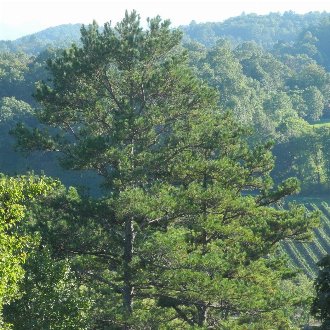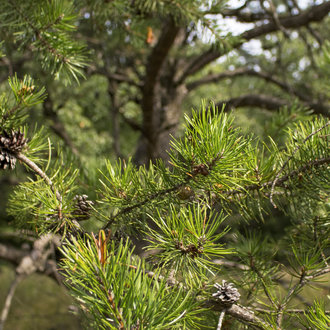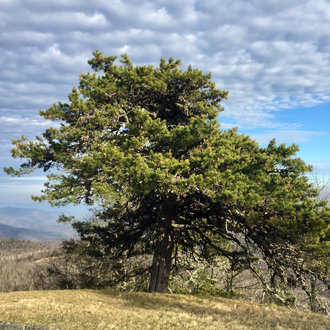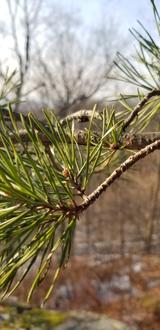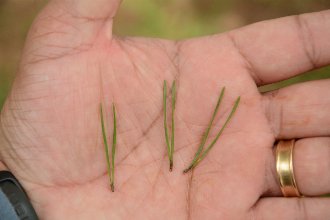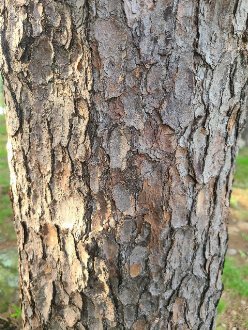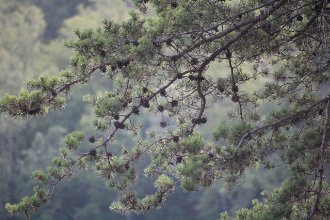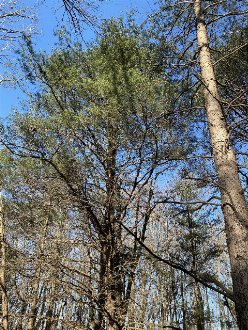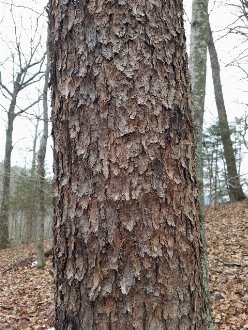Virginia Pine (Pinus virginiana Mill.)
↑Summary
A short-needled pine native mostly to the Appalachians and nearby, growing as a pioneer species on dry sites in hilly terrain.
↑Range - Expand
| Legend | Color |
| Native or Not Present | |
| Introduced | |
| Native | |
| Introduced or Not Present | |
| Native or Introduced |
This tentative map is based on our own research. It may have limited data on Canada and/or Mexico, and there is some subjectivity in our assignment of plants as introduced vs. expanded. Read more in this blog post.
Although this plant occurs somewhere in each of these regions, it may only occur in a small part of some or all of them.
↑Similar Plants
↑Habitat
Virginia pine is found in early successional growth on poorly-developed soils in and around the Appalachians from about the Mid-Atlantic southward. Towards the end of its lifecycle it is often found as relict trees in hardwood forests so long as the canopy does not exceed its height.
It is mostly found on soils of the spodosols and inceptisols orders. These soils can be derived from many different parent materials, including marine deposits, crystalline rocks, sandstones and shales, and sometimes limestone. It usually occurs on well-drained to excessiely drained, and slightly acidic soils that are somewhat sandy, but not too sandy. However, it tolerates a wide range of pH, from 4.6 to 7.9. It can thrive on clay soils but only on well-drained sites.
Virginia pine is mostly found in areas with hilly topography, between 50 to 2,500 feet (15-760 m) in elevation. It is not strictly dependent on hilly topography, but such topography tends to create the soil conditions it prefers, in which lower layers of mineral soil or less-well-developed soil become exposed.
It is an early colonizer of recently-burned sites as well as abandoned agricultural land on drier sites, especially in sloped terrain where soil management was poor and there was extensive erosion or topsoil loss. Although it colonizes sites that have experienced severe crown-destroying wildfire, it is not adapted to frequently-burning sites; all except the most mature trees are susceptible to fire, and even larger trees are only able to survive low-intensity ground fires, less tolerant of fire than most pines and some oaks.
On the harshest sites, such as serpentine or shale barrens, barrens with coarse sands, or exposed rock outcroppings, it is replaced by pitch pine (Pinus rigida), or at high elevations in the Appalachians, also by table mountain pine (Pinus pungens). It is mostly limited to sites where it will eventually be out-competed by other vegetation, usually hardwoods.
The associates of Virginia pine are different in different regions. On the rockiest sites at high elevations in the Appalachians, it occurs with pitch pine and table mountain pine. In the flatter, more coastally-inclined portions of its range, it often occurs with sweetgum and loblolly pine (Pinus taeda), and in the Piedmont it often grows with oaks and shortleaf pine (Pinus echinata). All these other species tend to outlive it.
Humans have increased the habitat for this species both my mining and through poor agricultural practices, especially in hilly terrain, which has degraded or stripped the topsoil, exposing the mineral soil that this species favors.
Although it is well-adapted to degraded soil, this species is less tolerant to air pollution, particularly ground-level ozone, and also to a degree sulfur and nitrogen oxides, and does not grow well in urban areas as a result.
↑Life Cycle
Virginia pine is a rapid-growing and short-lived evergreen tree. It is fast-growing even relative to other pines.
Seeds germinate in exposed mineral soil in high-light conditions. Seedlings are more tolerant of dry conditions than other pines, and can survive full sun exposures with no leaf litter. Drought slows growth but is unlikely to kill seedlings unless severe.
Trees usually begin producing seed at about 5 years of age, but trees have been recorded flowering as soon as 18 months. However, on sites where growth is suppressed by competing vegetation, seed production may be delayed as long as 50 years.
High volumes of seed are produced; cones open at maturity, and seeds are distributed a short distance by wind, most landing within 100 feet (30 m) of the parent tree.
Top-killed trees may resprout, but sprouts are usually short-lived. This tree does not usually reproduce vegetatively.
Trees usually live 65-90 years; they are usually eventually overtopped by more shade-tolerant species.
↑Faunal Associations
This species provides good habitat for woodpeckers, due to its rapid growth to maturity and the softness of its wood. It also provides cover for a variety of animals. The foliage is browsed by white-tailed deer, and the seeds are eaten by a variety of small mammals and larger birds, including the northern bobwhite. Meadow mice sometimes eat the bark of young seedlings.
Young stands of this species usually rapidly develop a dense shrub understory, improving their habitat for rabbits and birds, which benefit both from cover and food. As trees mature, the value to ground-level animals decreases and value to woodpeckers as nesting sites increases.
↑Control
Virginia pine has low potential to become invasive when planted close to its native range because it tends to get outcompeted by other vegetation, usually hardwoods, within 10-20 years, a shorter time span than within its native range.
↑Uses
Virginia pine is of little importance as a timber species due to its small size and poor form. Larger, straighter individuals of this species are occasionally mixed with other pines and sold generically as southern yellow pine. Its main uses historically have been for mine props, railroad ties, rough lumber, fuel, tar, and charcoal. Nowadays it is increasingly used for pulpwood, mainly due to its ability to grow on poor and degraded sites, and its tendency to grow in the early stages of land reclamation.
This species frequently colonizes abandoned mining sites, including surface coal mines and manganese mines. It is sometimes planted slightly outside its native range for this purpose, and usually does well on these sites.
In general, within its range, Virginia pine is useful in ecological restoration projects on upland sites where there has been erosion, topsoil loss, or soil degradation. On these sites it can accelerate soil development and speed the establishment of other vegetation, usually hardwood forests.
It has occasionally been used as a Christmas tree.
It is rarely used as a landscaping plant, where it is valued for its ability to grow on poor soils, its small maximum size, and its tolerance to deer browsing. Some cultivars exist, including dwarf cultivars and those with yellow foliage.
↑Related Plants
Virginia pine belongs to the Subsection Contortae, a subgroup of pines with two needles per bundle, that also tends to have short needles.
It is probably closest-related to sand pine (Pinus clausa), a species that mostly does not overlap with this one in range, extending into Florida and southern Georgia where this species is absent. These species can be made to artificially hybridize, but do not hybridize in the wild.
Other pines in this group include jack pine (Pinus banksiana), which has a more northerly range, also barely overlapping with this species, and lodgepole pine (Pinus contorta), a western pine with completely non-overlapping range.
↑Links & External Resources
• Virginia Pine | The Wood Database (About This Site)
• Virginia Pine | Fire Effects Information System (FEIS) (About This Site)
• Pinus virginiana (Virginia Pine) | USDA PLANTS Database (About This Site)
• Virginia Pine | Virginia Tech Dendrology Factsheets (About This Site)
• Virginia Pine | Silvics of North America (About This Site)
• Pinus virginiana | Biota of North America Project (BONAP) (About This Site)
• Pinus virginiana | NatureServe Explorer (About This Site)
• Pinus virginiana | Flora of North America (About This Site)
• Virginia Pine | Maryland Biodiversity Project (About This Site)
• Pinus virginiana Miller (Virginia Pine, Scrub Pine) | Digital Atlas of the Virginia Flora (About This Site)




